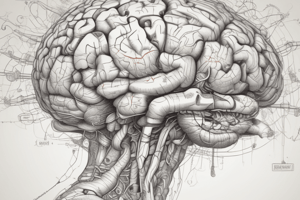Podcast
Questions and Answers
To which portion of the diencephalon is the pituitary gland attached?
To which portion of the diencephalon is the pituitary gland attached?
- Thalamus
- Epithalamus
- Hypothalamus (correct)
- Metathalamus
If diffusion across the arachnoid granulations decreases, what is the most likely effect on cerebrospinal fluid (CSF) volume?
If diffusion across the arachnoid granulations decreases, what is the most likely effect on cerebrospinal fluid (CSF) volume?
- CSF volume in the ventricles would decrease.
- CSF flow would reverse into the brain tissue.
- CSF volume in the ventricles would increase. (correct)
- There would be no significant change in CSF volume.
Damage to the primary motor cortex would most likely result in difficulties with which function?
Damage to the primary motor cortex would most likely result in difficulties with which function?
- Regulating heart rhythms
- Understanding language
- Initiating voluntary movements (correct)
- Processing sensory information
If someone experienced damage to the temporal lobes of their cerebrum, which sensory functions would be most affected?
If someone experienced damage to the temporal lobes of their cerebrum, which sensory functions would be most affected?
The thalamus acts as a relay point for most sensory information, except for which sense?
The thalamus acts as a relay point for most sensory information, except for which sense?
Flashcards
What part of the diencephalon is the pituitary gland attached to?
What part of the diencephalon is the pituitary gland attached to?
The pituitary gland, which connects the nervous and endocrine systems, is attached to the hypothalamus.
Where is the primary motor cortex located and what is its function?
Where is the primary motor cortex located and what is its function?
Damage to the primary motor cortex, located in the frontal lobe, can impair voluntary movement.
What senses are affected by damage to the temporal lobes?
What senses are affected by damage to the temporal lobes?
Damage to the temporal lobes can affect hearing, speech comprehension, and memory.
What type of sensory information doesn't pass through the thalamus?
What type of sensory information doesn't pass through the thalamus?
Signup and view all the flashcards
Why is damage to the medulla oblongata so dangerous?
Why is damage to the medulla oblongata so dangerous?
Signup and view all the flashcards
Study Notes
Major Functions of Brain Regions
- Cerebrum: Responsible for higher-level cognitive functions like thought, memory, and voluntary movement.
- Cerebellum: Coordinates movement, balance, and posture.
- Brainstem (Midbrain, Pons, Medulla Oblongata): Controls basic life functions like breathing, heart rate, and swallowing.
- Thalamus: Acts as a relay station for sensory information, except for smell.
- Hypothalamus: Regulates homeostasis, including body temperature, hunger, thirst, and sleep-wake cycles.
- Pituitary Gland: Links the nervous and endocrine systems, releasing hormones.
Pituitary Gland Attachment
- Attached to the hypothalamus.
Arachnoid Granulations and CSF Volume
- Decreased diffusion across arachnoid granulations would increase cerebrospinal fluid (CSF) volume in the ventricles.
Primary Motor Cortex Location
- Located in the frontal lobe of the cerebrum.
Temporal Lobe Damage Effects
- Damage to the temporal lobes affects auditory processing, language comprehension (Wernicke's area), and memory (especially long-term).
Thalamus Sensory Relay
- The thalamus does not relay olfactory (smell) information.
Diencephalon and Body Temperature
- The hypothalamus regulates body temperature.
Medulla Oblongata Damage
- Damage to the medulla oblongata is critical because it controls vital involuntary functions like breathing and heart rate; damage in the cerebrum may not be life-threatening.
Studying That Suits You
Use AI to generate personalized quizzes and flashcards to suit your learning preferences.
Description
Test your knowledge on the major functions of different brain regions, including the cerebrum, cerebellum, brainstem, and hypothalamus. Explore how these areas contribute to cognitive functions, movement coordination, and life-sustaining processes. This quiz is ideal for students learning about neuroanatomy.




